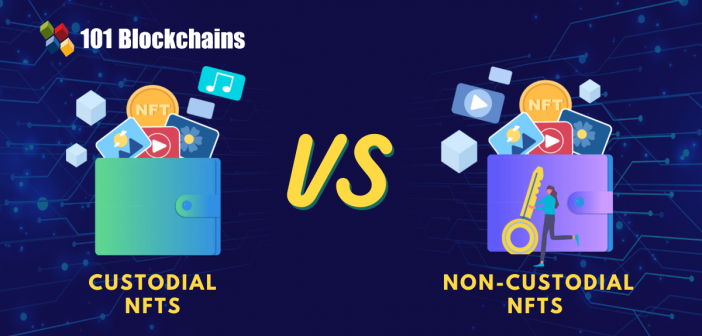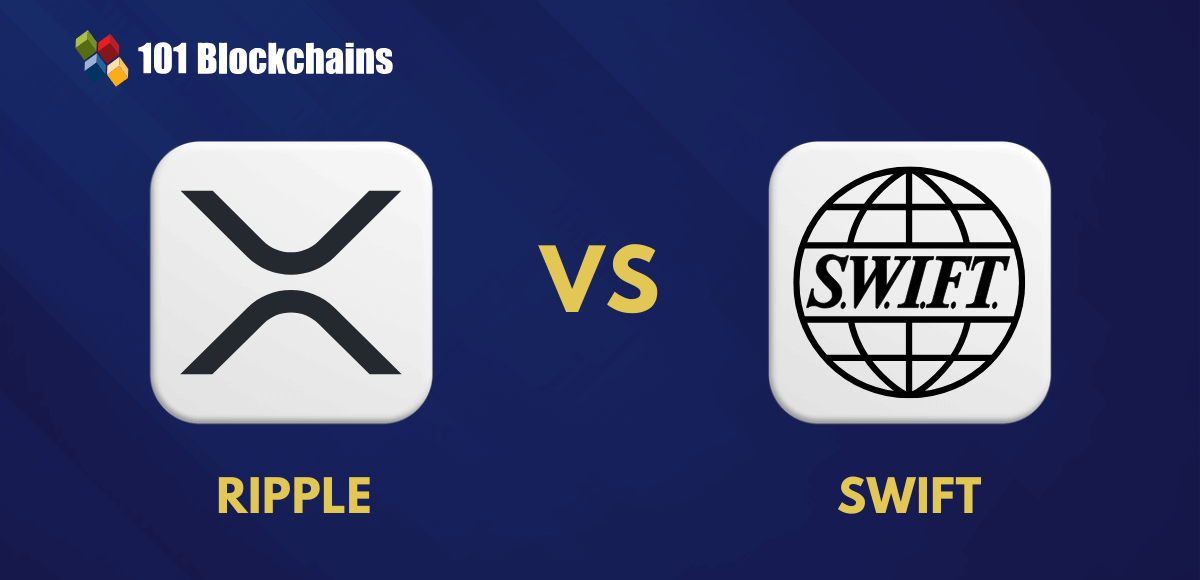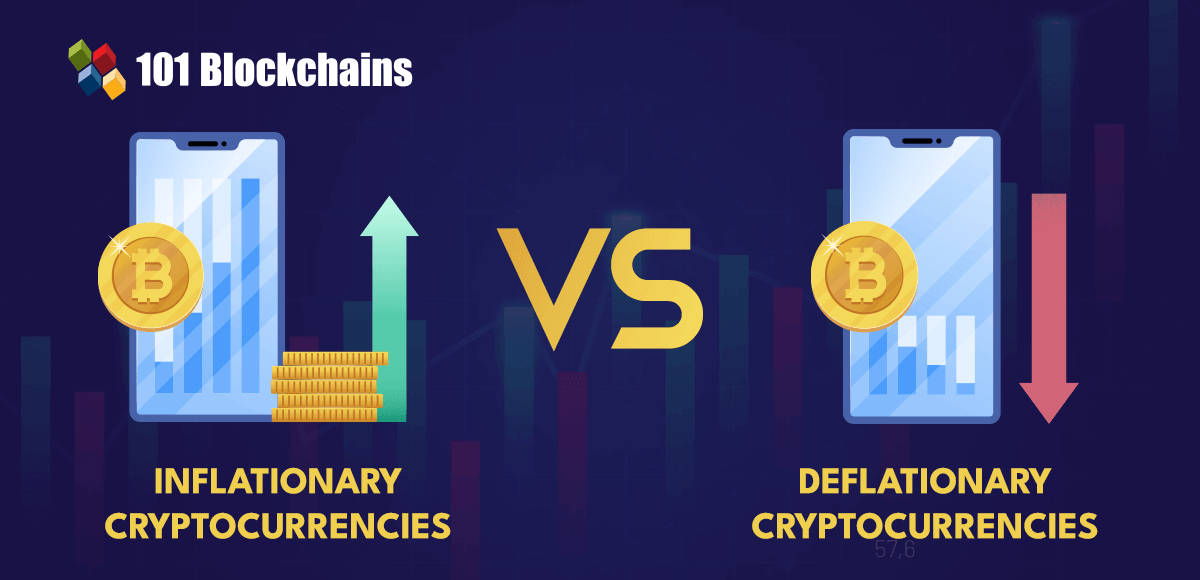Learn how blockchain truly works, master key definitions, and uncover what makes smart contracts so "smart." Dive into the fundamentals, gain valuable insights, and start your blockchain journey today!

Comparisons
James Howell
on March 21, 2022
Custodial vs Non-Custodial NFTs – Key Differences
NFTs or non-fungible tokens are one of the biggest trends in the world of technology. With the constantly growing popularity of NFTs, especially in art auctions and celebrity involvement with NFTs, many people are showing interest in the new digital assets. At this point in time, the custodial vs non-custodial NFTs debate is quite significant considering the massive scale of adoption of NFTs. If you have been following the crypto space closely, then you must have come across the terms DeFi and NFT. Non-fungible tokens are slowly becoming an integral part of emerging DeFi solutions, and you can also think of metaverse applications.
With so much potential in NFTs, one should definitely wonder about the concerns of custodianship with non-fungible tokens. This is where you come across the difference between custodial and non-custodial NFTs to find the ideal choice for NFT custody. The following discussion helps you understand custodial and non-custodial NFT wallets alongside the differences between them. You can use the differences to find whether custodial NFTs serve as a better option than the NFTs in non-custodial wallets.
Basics for Custodial vs Non-custodial NFTs Comparison
Before diving into an outline of differences between custodial and non-custodial NFTs wallets, you need to understand the significance of custody. The hype around NFTs has definitely filled the online space with a lot of information on them. However, you can barely find any discussions in the crypto space directed towards custodianship of NFTs. Do you know who controls your NFT after you have created or purchased one? While NFTs offer the promise of sole ownership over the concerned asset, you may not have complete control over the NFT. How?
You can let third-party take custody of your NFT and take care of it on your behalf. On the other hand, you can also take custody of your NFT. Therefore, you can notice the foundations of the custodial vs non-custodial NFTs debate emerging from the differences in types of wallets for storing them. In addition, the platforms used for creating and trading NFTs also play a crucial role in differentiating custodial NFTs from the non-custodial variants.
Learn the concept, elements, future and use cases of NFTs from the E-book: Non Fungible Tokens (NFTS) – A Definitive Guide
Importance of Crypto Wallets
Crypto wallets, just like your physical wallets, help in storing cryptocurrencies and facilitating transactions with desired blockchain networks. You need a crypto wallet for using decentralized applications or making transactions on a blockchain network. The two most significant aspects of any wallet refer to a public key and the private key. Interestingly, you can use crypto wallets for storing NFTs, depending on the type of crypto wallet.
Since NFTs are basically tokens on a blockchain network, you won’t experience any troubles storing your NFT in crypto wallets. If crypto wallets can store NFTs, then why do you have to find the difference between custodial and non-custodial NFTs? You can find the answer to the question by reflecting on the individual definition of custodial and non-custodial variants of NFTs.
Build your identity as a certified blockchain expert with 101 Blockchains’ Blockchain Certifications designed to provide enhanced career prospects.
What is a Custodial NFT?
If you want to know the definition of custodial NFTs, then you must reflect on the basic definition of custodial crypto wallets. The custodial crypto wallets do not offer complete control over the private keys to the wallet owners. On the contrary, a third party, like a custodial wallet service provider or an exchange, helps in storing and managing your private keys and related assets. You can store your NFT in a custodial crypto wallet, and it automatically answers “What is a custodial NFT?” as you entrust the access to your NFT in another platform. How far is it reasonable to place the control of your valuable NFTs in the hands of a third-party custodian?
A third-party custodian could ensure better support in storage and management of private keys required for accessing custodial NFTs. You can pass the responsibility of private keys to your NFT to the custodian. Furthermore, you can also receive support from the NFT custodian in situations where you forget your password for accessing the custodian’s services. However, one of the prominent highlights in answer to “What is a custodial NFT?” emphasizes entrusting custody of NFTs to a third party. Therefore, custodial NFT owners have to rely on the security mechanisms of the custodial for the safety of their NFTs.
Want to know some of the prominent vulnerabilities and security risks associated with NFTs? Read Now: NFT Vulnerabilities And Security Concerns
What is a Non-custodial NFT?
After an overview of custodial NFT basics, it is important to learn about non-custodial NFTs for drawing reasonable differences. Similar to the case of custodial crypto wallets, you can identify answers to “What is a non-custodial NFT?” with non-custodial crypto wallets. The non-custodial wallets are crypto wallets that entrust the control of private keys to the asset holder. You can think of non-custodial NFTs as the ones you can put in a non-custodial wallet. The option of non-custodial wallets is suitable for users who demand better control over their NFTs.
On the other hand, the NFT owners have to take responsibility for the security of their valuable assets. You have to remember the private keys and backup seed phrase for ensuring safety of your NFTs. However, non-custodial wallets provide flexibility of use alongside additional enhancements for secure storage of private keys.
Become a member now to watch our on-demand webinar on Demystifying Non-Fungible Tokens (NFTs).
Differences between Custodial and Non-custodial NFTs

Please include attribution to staging2.staging2.101blockchains.com with this graphic. <a href='https://staging2.staging2.101blockchains.com/blockchain-infographics/'> <img src='https://staging2.staging2.101blockchains.com/wp-content/uploads/2021/12/Metaverse-vs-Multiverse-1.png' alt='Custodial vs Non Custodial NFTs='0' /> </a>
The basic overview of custodial NFTs and their non-custodial counterparts shows that the difference between them rests primarily on the type of wallet. However, you can discover many other differences between custodial and non-custodial NFTs on the grounds of other factors. A detailed comparison between custodial and non-custodial NFT with respect to various points of difference can help you find the ideal choices according to your requirements.
-
Definition
The fundamental aspect for comparison in a custodial vs non-custodial NFTs debate refers to their definition. Interestingly, you don’t have to encounter any complicated propositions when comparing custodial and non-custodial NFT variants in terms of definition.
As a matter of fact, the definition of custodial NFTs and their non-custodial counterparts relies heavily on the type of wallet used for storing the NFTs. If an NFT is in a custodial crypto wallet, it is a custodial NFT. On the other hand, NFTs in non-custodial wallets qualify as non-custodial NFTs.
In the case of a custodial NFT, you have to allocate the control of private keys to the wallet service provider. Basically, you will have to entrust the control over your NFTs to a third-party custodian with a custodial NFT. On the other hand, the NFT owner enjoys complete control over their asset in the case of a non-custodial NFT.
Want to know the different types of crypto wallets? Read Now: Types of Crypto Wallets
-
Methods of Purchasing
The next important point of difference between custodial and non-custodial NFTs would refer to the methods of purchasing them. You can decide the method of purchasing depending on the level of control you want to have on your NFT.
The best way to purchase non-custodial NFTs refers to a decentralized platform. Popular decentralized exchanges such as Binance DEX showcase the perfect example of a non-custodial wallet for NFTs. You don’t have to fulfill any basic requirements for creating accounts or signing up for the services of a third-party provider. In addition, the custodial vs non-custodial NFTs comparison also focuses on how the non-custodial variants facilitate direct trades between wallets.
The methods for purchasing custodial NFTs would include prominent references to an NFT marketplace. The marketplace would serve as a custodian for the NFT during the purchase process. For example, you have to send funds to the custodian if you want to purchase a custodial NFT through them. You can choose to keep the NFTs in the custodial wallet or transfer them to non-custodial wallets.
Want to get an in-depth understanding of non-fungible tokens (NFTs)? Enroll Now in NFT Fundamentals Course
-
Accessibility
The significance of accessibility as a prominent factor of difference between custodial and non-custodial NFTs is clearly evident. People wouldn’t have to wonder about the time they could access the NFTs they own. However, is it really necessary to let anyone access NFTs?
When you think of crypto and NFTs, you can obviously draw some hints at democratization. After all, the basic vision of blockchain focuses on democratizing access to the digital world. However, custodial NFTs present a different perspective on the same. You can store custodial NFT in a wallet only after completing the formalities of account registration and KYC verification. On the other hand, non-custodial NFTs paint a different picture by allowing accessibility to anyone. A non-custodial NFT service is accessible to anyone without the need for registering an account or completing KYC verification procedures.
-
Transaction Costs
The transaction costs associated with custodial and non-custodial NFT variants also serve an important role in custodial vs non-custodial NFTs comparisons. Since the custodian would invest resources in storage and management of private keys to your NFTs, they would obviously charge you a price for the same.
In the case of custodial NFTs, transaction costs are generally higher due to involvement of the custodian. On the contrary, a non-custodial NFT provides the assurance for generally lower transaction costs. With the limited parties involved in non-custodial NFTs, you can have the assurance of reduced transaction costs.
-
Security
The element of security will always serve as a profound highlight in the difference between custodial and non-custodial NFTs in all cases. Storage and management of private keys with custodial and non-custodial NFT variants define the foundations of security. In the case of a custodial NFT, the NFT owner has to place control of their private keys with the service provider.
As a result, you have to rely on the efficiency of the NFT custodian’s security infrastructure to determine the security status for your NFTs. On the contrary, non-custodial NFTs are a step apart by allowing complete control of private keys to the NFT owner. In the case of a non-custodial NFT, you have the final say in the security of the private keys. Therefore, you can have the assurance of better security in non-custodial NFT by implementing personalized security mechanisms.
Get familiar with the basic and advanced Non-Fungible Token (NFT) terms with the NFT flashcards!
-
Support
The final aspect for comparison in the custodial vs non-custodial NFTs debate would bring the topic of support into consideration. Custodial NFT platforms provide the assurance of support in the event of losing your password to the exchange. On the other hand, you may lose access to your NFTs permanently in the case of non-custodial NFT platforms, which offer limited support.
Final Words
On a final note, it is clear that custodial and non-custodial NFTs have been tailored for different purposes. Depending on the type of custody you want for the NFT you have created or purchased, custodial NFTs and their non-custodial counterparts present distinct value advantages. For example, you are free from responsibilities of managing private keys with a custodial NFT.
On the other hand, you have to compromise on the control you can exert over your NFTs. In the case of non-custodial NFTs, you can find improved prospects for security, albeit with limited support. If you lose your private keys for a non-custodial NFT, then you can very well bid goodbye to it. Learn more about NFTs and choose the best variant which fits your bill.
*Disclaimer: The article should not be taken as, and is not intended to provide any investment advice. Claims made in this article do not constitute investment advice and should not be taken as such. 101 Blockchains shall not be responsible for any loss sustained by any person who relies on this article. Do your own research!






